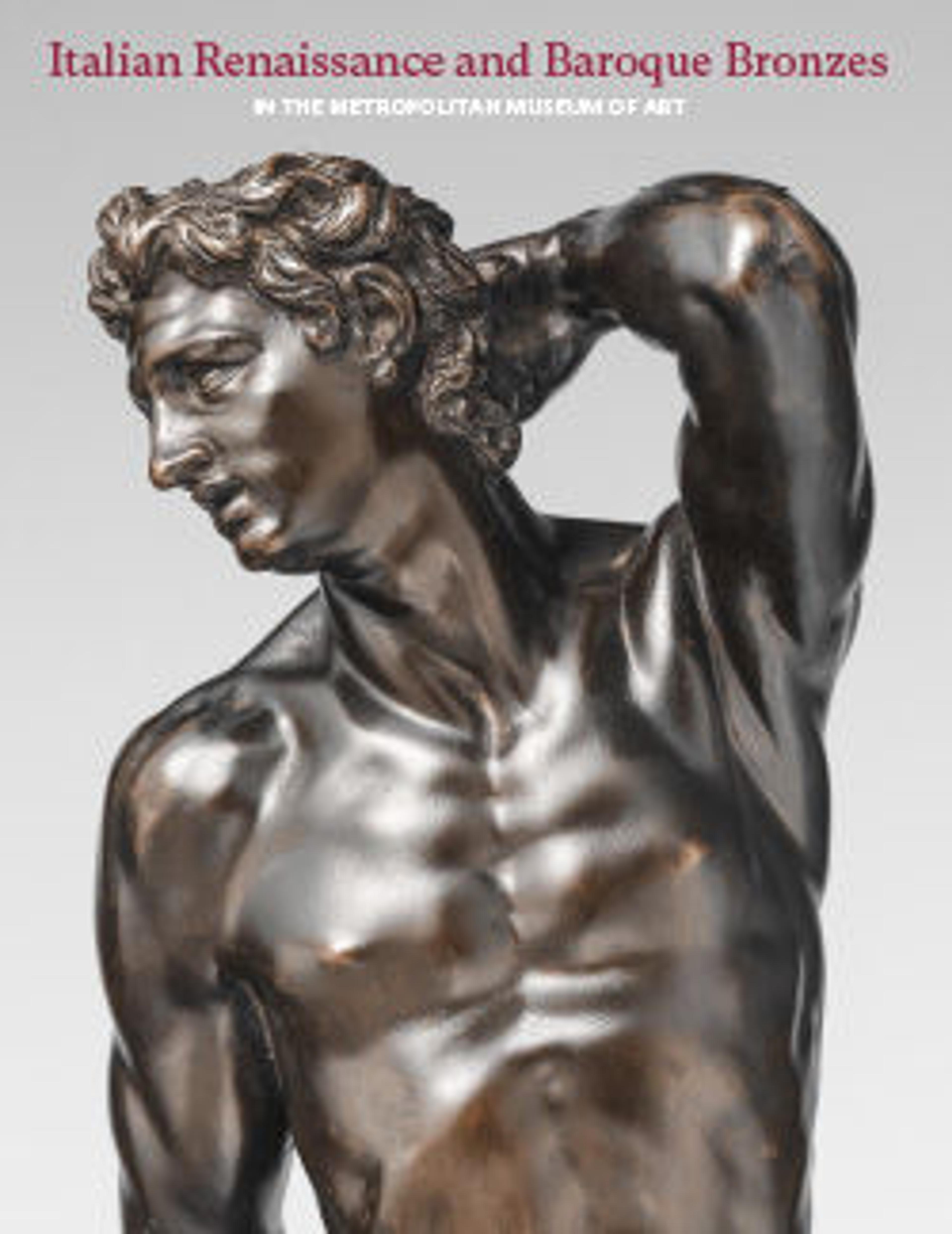Saint Christopher
The holy Christophoros (Christ Bearer) was venerated by countless voyagers, navigators, and athletes. Twelve cubits tall, according to The Golden Legend, he bore the Christ Child, “heavy as lead,” across a swollen river. The little boy with a globe and the giant’s pole for fording the stream are missing from the present example. Bertrand Jestaz, recognizing the model’s kinship with Severo’s Neptune statuettes (cat. 37), advanced considerably our understanding of the artist when he found that the hole in the flattened hand of a Saint Christopher in the Louvre originally stabilized a Christ Child now in the National Gallery of Art, Washington, D.C., by means of the short pin in the child’s underside (they have since been regularly reunited; see fig. 33a). The Louvre figure lacks the circular fibula found on our saint’s right shoulder. Another lone Saint Christopher is in the Bode-Museum.[1] Despite the latter’s noticeable flaw in front, all three specimens are of a quality that is high for Severo, who evidently took pains with the model, if not with the execution. Jestaz and Patrick De Winter discuss how each was cast in three sections and soldered together horizontally, and Dylan Smith presents a radiograph of the Washington saint showing a fairly simple network of core pins, arguing that their systemization grew more complex as the workshop evolved, making this a fairly early work.[2]
The saint, with his zigzagging, well-rounded limbs and delicately gathered “Roman” tunic, is one of Severo’s largest serial creations, and one of his most energetic and appealing. It shares more with late medieval norms than with the budding Renaissance, another reason to date it fairly early in his output. For the garment, reasonable parallels are found in the mantle of the Saint John the Baptist in the Ashmolean,[3] which in turn comes closest in Severo’s oeuvre to his finest creation, the signed marble of the Forerunner in the Basilica di Sant’Antonio in Padua, with its even more emphatic fish-hook patterns in the folds of the cloak (p. 00, figs. 2d–e).
-JDD
Footnotes
(For key to shortened references see bibliography in Allen, Italian Renaissance and Baroque Bronzes in The Metropolitan Museum of Art. NY: The Metropolitan Museum of Art, 2022.)
1. Planiscig 1930, pl. 39.
2. D. Smith 2008, p. 53, fig. 14. Our Christopher was cast in a brass alloy with a small amount of lead and trace impurities. R. Stone/TR, 2016.
3. Warren 2014, pp. 117–24, no. 34.
The saint, with his zigzagging, well-rounded limbs and delicately gathered “Roman” tunic, is one of Severo’s largest serial creations, and one of his most energetic and appealing. It shares more with late medieval norms than with the budding Renaissance, another reason to date it fairly early in his output. For the garment, reasonable parallels are found in the mantle of the Saint John the Baptist in the Ashmolean,[3] which in turn comes closest in Severo’s oeuvre to his finest creation, the signed marble of the Forerunner in the Basilica di Sant’Antonio in Padua, with its even more emphatic fish-hook patterns in the folds of the cloak (p. 00, figs. 2d–e).
-JDD
Footnotes
(For key to shortened references see bibliography in Allen, Italian Renaissance and Baroque Bronzes in The Metropolitan Museum of Art. NY: The Metropolitan Museum of Art, 2022.)
1. Planiscig 1930, pl. 39.
2. D. Smith 2008, p. 53, fig. 14. Our Christopher was cast in a brass alloy with a small amount of lead and trace impurities. R. Stone/TR, 2016.
3. Warren 2014, pp. 117–24, no. 34.
Artwork Details
- Title: Saint Christopher
- Artist: Attributed to Severo Calzetta da Ravenna (Italian, active by 1496, died before 1543)
- Date: early 16th century
- Culture: Italian, Probably Padua
- Medium: Bronze
- Dimensions: Height: 10 1/4 in. (26 cm)
- Classification: Sculpture-Bronze
- Credit Line: Gift of Irwin Untermyer, 1964
- Object Number: 64.101.1410
- Curatorial Department: European Sculpture and Decorative Arts
More Artwork
Research Resources
The Met provides unparalleled resources for research and welcomes an international community of students and scholars. The Met's Open Access API is where creators and researchers can connect to the The Met collection. Open Access data and public domain images are available for unrestricted commercial and noncommercial use without permission or fee.
To request images under copyright and other restrictions, please use this Image Request form.
Feedback
We continue to research and examine historical and cultural context for objects in The Met collection. If you have comments or questions about this object record, please contact us using the form below. The Museum looks forward to receiving your comments.
